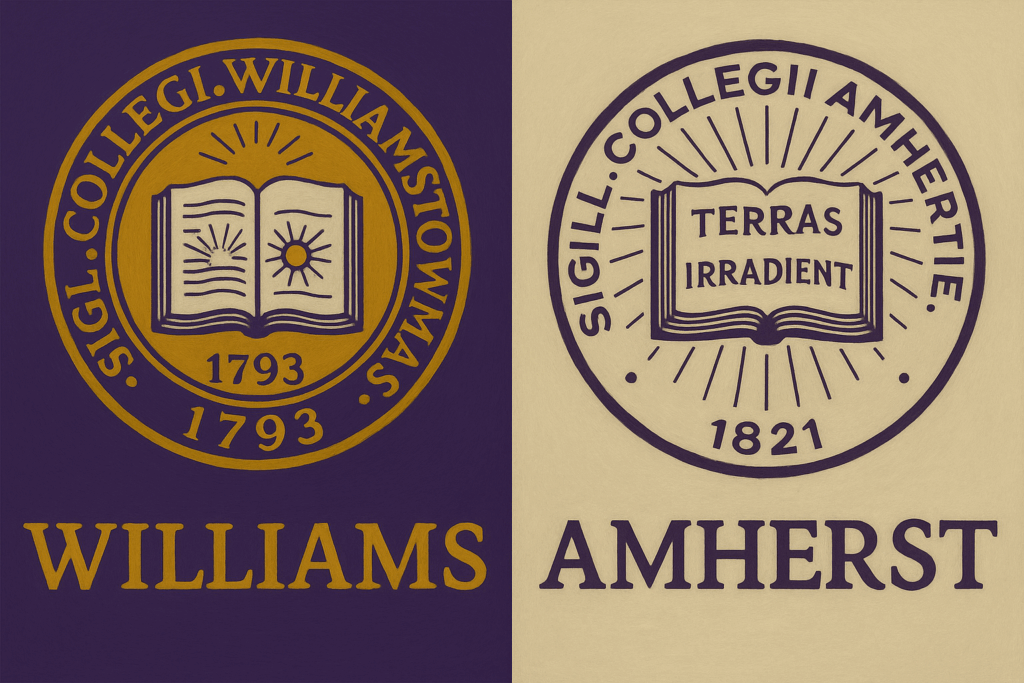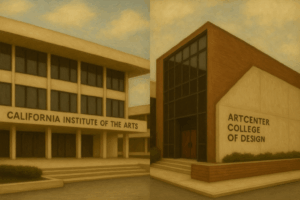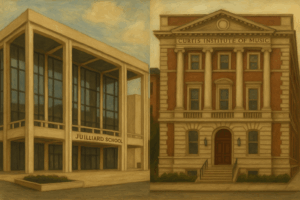
The GOAT of Liberal Arts Colleges?
When discussing the pinnacle of American higher education, alongside the Ivy League, the names of Liberal Arts Colleges are always mentioned. Among them, two schools consistently battle for the undisputed No. 1 and No. 2 spots in the U.S. News & World Report rankings: Williams College and Amherst College.
It’s difficult to understand the essential differences between these two schools by rankings alone. Williams and Amherst have remarkably similar statistics, but a closer look reveals distinct personalities, from their founding histories to their educational philosophies and campus cultures. Interestingly, the histories of the two schools are deeply intertwined, with the existence of one directly influencing the birth of the other.
This post, based on the latest 2025 information, aims to provide a deep, internal analysis of these two schools to offer practical help for students dreaming of attending America’s top liberal arts colleges in finding their best ‘fit.’
A Side-by-Side Look: 2025 Key Metrics Comparison
Before a full analysis, let’s compare the key data of the two schools to get an overall picture.
| Metric (2024-2025) | Williams College | Amherst College |
|---|---|---|
| 2025 U.S. News Ranking | 1st | 2nd |
| Year Founded | 1793 | 1821 |
| Location | Williamstown, MA (Rural) | Amherst, MA (Suburban Small Town) |
| Total Undergraduates | ~2,100 | ~1,900 |
| Class of 2029 Acceptance Rate | 8.5% | ~7% |
| Faculty-to-Student Ratio | 7:1 | 7:1 |
| Endowment (as of 2024) | ~$3.7 Billion | ~$3.5 Billion |
This table clearly shows just how similar the two schools are. From an applicant’s perspective, it’s very difficult to choose one over the other based on these numbers alone. But this is precisely where the importance of qualitative analysis comes in. From now on, we will delve deep into the history, philosophy, and culture of these two giants to clarify their differences.
History and Founding Philosophy: Two Giants Forged by Competition and Cooperation
The key to understanding the relationship between Williams and Amherst lies in their origin story. They are not just rivals; they have a fateful relationship where the crisis of one led to the birth of the other.
Williams College: The Will of the Western Frontier and the Birth of Education
The history of Williams College begins in 1793 with a ‘free school’ established in the desolate region of Massachusetts’ western frontier. However, its geographical isolation, nestled deep in the Berkshire Mountains, was a major obstacle to the school’s development.
- The Fateful Turning Point: In 1821, Zephaniah Swift Moore, the second president of Williams, was pessimistic about the school’s future. Concluding that Williams had no chance of survival, he decided to leave the school with some students and faculty to establish a new college in a more prosperous area. This was the beginning of Amherst College.
Amherst College: The Harmony of Faith and Intellect, The Start of a New Education
Amherst College was founded in 1821 by those who left Williams. Its initial purpose was to train poor young men to become ministers, and it grew by overcoming the geographical isolation that had been Williams’ downfall and by connecting with the surrounding local communities.
Insight: Excellence Forged by Rivalry
Their relationship, which began with ‘betrayal’ and competition, paradoxically became the driving force that elevated both schools to the highest level in the United States.
- To survive its crisis, Williams transformed its geographical isolation into a strength, fostering a tight-knit, self-sufficient culture focused on academics and community without external distractions.
- As a latecomer, Amherst had to prove its reason for being. It presented an open and flexible educational model through curricular innovation and active collaboration with external institutions.
Academic Culture and Educational Systems: Two Paths to the Summit
The two schools show clear philosophical differences in how they provide a top-tier undergraduate education. Williams emphasizes ‘depth,’ while Amherst emphasizes ‘breadth’ and ‘freedom.’
Williams College: Oxford-Style Tutorials and In-Depth Inquiry
The essence of a Williams education is its Tutorial system.
- It’s an Oxford-style class where one professor and just two students engage in an in-depth discussion on a specific topic for an entire semester. Each week, one student presents an essay, the other critiques it, and the professor guides the discussion, stimulating critical thought. This is a true ‘intellectual workout’ that goes beyond simple knowledge transfer and is the crystallization of the ‘in-depth inquiry’ that Williams pursues.
- Signature Academic Fields:
- Art History: Boasts an unparalleled environment for studying original works, thanks to the adjacent, world-renowned Clark Art Institute.
- Economics: Possesses research capabilities that surpass many comprehensive universities, with one of the highest rates in the U.S. of graduates pursuing a Ph.D. in economics.
Amherst College: The Open Curriculum and Intellectual Freedom
The most defining feature of an Amherst education is its Open Curriculum.
- Amherst has no general education requirements. Students only need to fulfill a first-year seminar and their major requirements. For the rest of their courses, they can choose freely from thousands of classes based on their intellectual curiosity, including those in the Five College Consortium. This grants students maximum autonomy and responsibility to design their own educational path.
- Signature Academic Fields:
- English: Boasts a deep literary heritage, having produced innovative writers like Robert Frost and David Foster Wallace.
- Political Science: Characterized by a wide range of courses covering diverse fields and an active faculty research agenda.
- Law, Jurisprudence, and Social Thought (LJST): A signature interdisciplinary major at Amherst that approaches law as a subject of humanistic inquiry.
Campus Culture and Student Life: A Community in Isolation vs. An Open Ecosystem
Williams: A Tight-Knit Community Forged by Isolation
The tradition that best symbolizes Williams’ culture is ‘Mountain Day.’ On a Friday morning in October, following an unannounced declaration by the president, all classes are canceled, and students hike up Mount Greylock together. This tradition perfectly showcases Williams’ communal, tradition-valuing, and deeply nature-connected culture.
Amherst: A Vibrant Ecosystem Created by Five Colleges
Campus life at Amherst expands across five campuses thanks to the Five College Consortium. Students take the free shuttle bus to take a class at Smith or attend a party at UMass, experiencing a much larger and more diverse social environment.
A Shared Festival: ‘The Game’
The Williams vs. Amherst football game, dubbed ‘The Biggest Little Game in America,’ is more than just a sport; it’s a festival where the pride of both schools, a rivalry spanning over 200 years, is on the line.
Alumni Who Move the World: An In-Depth Comparison of Impact
The true value of a university is measured by the impact its graduates have on society.
Williams College: Traditional Leadership and In-Depth Expertise
A Williams education excels at nurturing individuals who exercise leadership in core sectors of society, based on deep and analytical thinking skills. Graduates stand out in the traditional centers of power and culture, such as politics, law, finance, and the arts. The logical and systematic approach cultivated through the tutorial system becomes the foundation for them to grow into ‘Maestros’ in their respective fields.
- James A. Garfield: The 20th President of the United States, symbolizing the spirit of public service at Williams by reaching the nation’s highest office.
- Stephen Sondheim: A legendary composer and lyricist who changed the history of Broadway musicals. He elevated the musical to an art form with works like ‘West Side Story’ and ‘Sweeney Todd.’
- Elia Kazan: A leading American film and theater director of the 20th century, who directed ‘A Streetcar Named Desire.’
- Steve Case: Co-founder of America Online (AOL) and a pioneering entrepreneur who ushered in the internet age.
- Lina Khan: The current Chair of the U.S. Federal Trade Commission (FTC), noted for her sharp critiques of Big Tech monopolies.
- Goh Chok Tong: The second Prime Minister of Singapore, who led the nation’s economic development.
- Herbert H. Lehman: Governor of New York and co-founder of Lehman Brothers, a figure who reached the pinnacle in both finance and public service.
- Earl A. “Rusty” Powell III: Former director of the National Gallery of Art in Washington, D.C., one of the top leaders in the American art world.
Amherst College: Intellectual Innovators and Creative Pioneers
Amherst’s Open Curriculum grants students intellectual autonomy, which becomes a fertile ground for producing innovators and creative individuals who break existing molds and open new horizons. Graduates have left a distinctive mark, especially in literature, thought, and fields that reshape industries in new ways. The image of the ‘Pioneer,’ who forges their own path rather than following a prescribed one, is strong.
- Calvin Coolidge: The 30th President of the United States, a historic figure who showed that an Amherst graduate could become the nation’s top leader.
- David Foster Wallace: An author who opened a new chapter in postmodern literature with his novel ‘Infinite Jest.’ He had a profound influence on modern literature.
- Dan Brown: The novelist who became a global bestselling author with ‘The Da Vinci Code.’
- Joseph Stiglitz: A Nobel laureate in Economics and a world-renowned scholar who offers a critical voice against mainstream economics.
- Charles Merrill: An innovative financier who co-founded Merrill Lynch with the philosophy of ‘Bringing Wall Street to Main Street.’
- Jeffrey Wright: A versatile Tony and Emmy Award-winning actor who perfectly portrays intellectual characters in works like ‘Westworld’ and ‘Basquiat.’
- Henry Clay Folger: President of Standard Oil and founder of the Folger Shakespeare Library, which houses the world’s largest collection of Shakespeare’s works.
- Albert II: The current reigning monarch of the Principality of Monaco.
Conclusion: Which is the Best Choice for You?
The choice between Williams and Amherst is not a process of finding the ‘better’ school, but a journey to find the school that is a ‘better fit for me.’
- Williams College: ‘The Perfected Classic’
This is an ideal environment for students who value deep scholarly inquiry, represented by the Oxford-style tutorial, and a tight-knit, traditional community forged by geographical isolation. If you seek mastery through depth, Williams will be the best choice. - Amherst College: ‘The Innovative Hybrid’
This is the optimal place for independent students who crave intellectual autonomy and broad exploration, symbolized by the Open Curriculum and the Five College Consortium. If you want exploration through breadth, forging your own path, Amherst will offer limitless possibilities.
On these two paths of excellence, carefully reflecting on your learning style, personality, and vision for the future is the most important first step toward making a choice you won’t regret.


